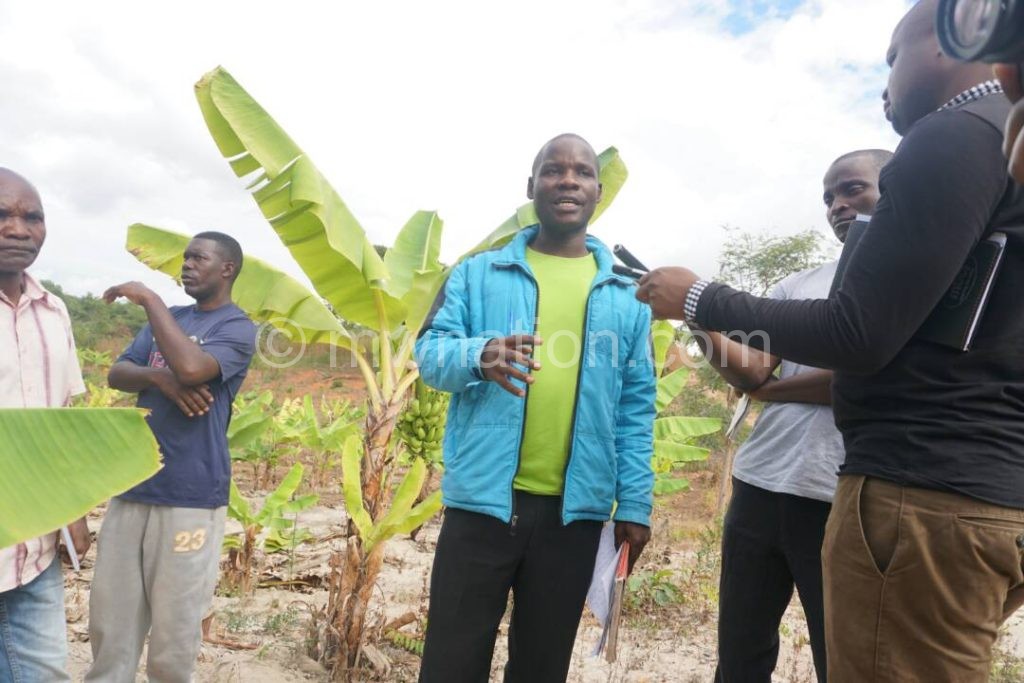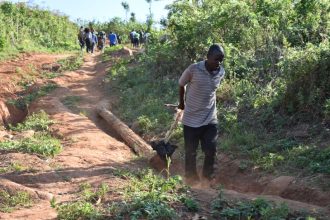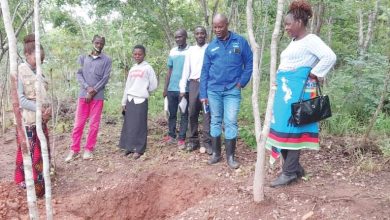Battling to save bananas in Nkhata Bay
Bananas are one of the traditional crops in Nkhata Bay. However, facing extinction due to Banana Bunchy Top Virus, communities are undertaking efforts to save the crop. Thanks to UNDP-funded Adapt plan, a new variety is being tried to bring bananas back on peoples plates. Our Staff writer MOSES MICHAEL-PHIRI reports:
In Nkhata Bay, bananas are serious business. About 50 percent of farmers’ incomes come from bananas—the second most important crop in the district after cassava.

A banana meal is simple. In the morning, one can brighten their morning with boiled bananas and tea for breakfast. Not only is this combination healthy, but it’s also satisfying and quick.
At lunch, boiled bananas taken with chicken soup or beef stew easily fits the bill. Yellow ripe sweet bananas make good dessert too.
Bananas are easy money. On the local market, they sell like hot cakes. A bunch or kilogramme sells between K500 to K1 000. At commercial farming level, banana farmers make huge profits.
Sambandopa Mphande, a farmer from Chiphazi village in Traditional Authority Mkumbira’s area knows well how rewarding bananas can be.

“I have educated my children with proceeds from bananas. I built a house and use the income to support my family,” he explains.
The 58-year-old farmer recalls how Nkhata Bay used to have massive banana plantations in the middle of the lush greenery in the mountain sides.
But in 2004 a deadly virus started attacking banana plants. He says farmers watched in shock as banana plants started to wilt and die.
“We were astonished, banana plants were falling and drying just like that,” says Mphande. “There was very little we could do.”
When agriculture extension workers came to Lweya-Limphasa valley they broke the bad news to farmers.
“They said it was a virus called Banana Bunchy Top Virus [BBTV]. The virus was attacking bananas across the country and around the world,” he recalls.
Banana bunchy top—first noted in Malawi around Thiwi area in Nkhotakota in 1994 but confirmed in 1997—is caused by a virus which is spread by an aphid called Pentalonia negronervosa.
The virus is spread from one area to another through the use of diseased planting materials. But there are also worries that as climate changes, those pathogens easily breed.
Plants infected at an early growth stage are severely dwarfed and do not bear fruit, and the virus is considered to be the most economically destructive virus disease affecting bananas worldwide.
When the virus has attacked a banana plantation, farmers lose both income and time as they waste time uprooting attacked plants.
The BBTV attack has also led to a sharp decline in banana production in the country.
Statistics from Food and Agriculture Organisation (FAO) show that Malawi was on a steady path as the crop was on the increase in production from 1999. The harvest that year hit 300 000 tonnes from 93 000 tonnes in 1998.
It reached its peak in 2009 and 2010 harvesting about 400 000 tonnes and 410 378 tonnes, respectively, before starting registering a drop in production in the succeeding years due to the virus.
As of 2013, the harvest had fallen to 386 345 tonnes before dropping further to below 200 000 tonnes.
So are bananas plants doomed?
“It’s not completely hopeless,” says Michael Makonombera, deputy director in the Department of Environmental Affairs.
The department with support from UNDP Adapt Plan programme is implementing several intervention projects in Nkhata Bay to build resilience of the farmers.
To deal with BBTV virus, Adapt plan is working with farmers on ways to contain the pestilences, and multiply new varieties that have a better shot at surviving.
Farmers, through Comsip corporatives are currently multiplying a resilient banana variety called William.
“The Banana Bunchy Top Virus is spread fast due to poor mat management. So the project is trying to promote William variety which is tolerant to the virus and improves field management.
“We are implementing the project in Nkhata Bay because we know that bananas play a vital role in food security which is currently compromised by impacts of climate change,” he explains.
So far, 20 community groups—involving 154 males and 183 females—are multiplying resilient banana variety.
At Chisu Banana Site, farmers under Umoza Muli Thazi Group which Mphande is the chairperson have planted 200 BBTV-free banana as catchment conservation.
“The new bananas grow so fast. When they shoot, the shots are given to other farmers to plant.
“For example, I have transferred some of the banana plants to my small field where the crop is doing well,” Mphande says.
From the catchment, he says the farmers are also reaping the fruit for sell.
“The variety is highly productive. So far, we are already harvesting some bananas for sale,” he adds.
The Adapt Plan uses community based adaptation approach to identify activities.
So far, communities are engaged in agriculture productivity enhancement for increased food security, ecological entrepreneurship to revitalise forest ecosystems and community based entrepreneurship to promote small-scale industries in food, confectionaries and textile making.
Winnie M’bama, another farmer involved in seed multiplication is all smiles.
She says the new banana variety has brought hope to many farmers who feared the crop would be wiped out totally.
“The banana crop is important here in Nkhata Bay as it is one of the main crops. So far, we are excited with the new variety as it is very resilient,” she says.
Apart from saving bananas from extinction, in Nkhata Bay the Adapt Plan priority is how to preserve the natural resource base in terms of forests and the lake so that the communities can maintain their environmental integrity.
According to Makonombera, they selected the Lweya-Limphasa valley area, covering six Traditional Authorities (TAs), namely Fukamalaza, Mankhambira, Mkumbira, Timbiri, Kabunduli and Mnyaluwanga which fall in seven extension planning areas to benefit from the trial plan.
The Lweya-Limphasa valley area has a population of 140 143 people with over 23 000 farming families, representing 55 percent of the total farming families present in Nkhata Bay district who grow cassava and bananas as the predominant food crop.
But why save bananas?
Makonombera says the banana crop makes a substantial contribution to the Malawi economy.
Researchers estimate it could be contributing around two percent of gross domestic product (GDP)
“This is why government is worried that these fruits are in deep trouble. Already, consumers are being forced to import bananas from Tanzania, South Africa and Mozambique for domestic consumption.
“In the face of a changing climate which poses a threat to food security, farmers need to save the banana plants,” Makonombera says.





